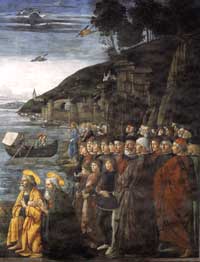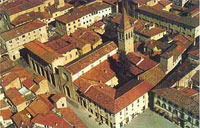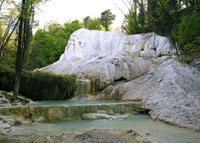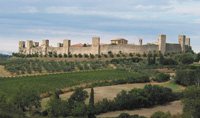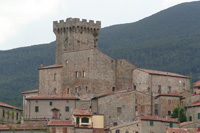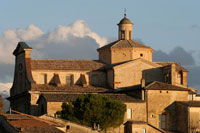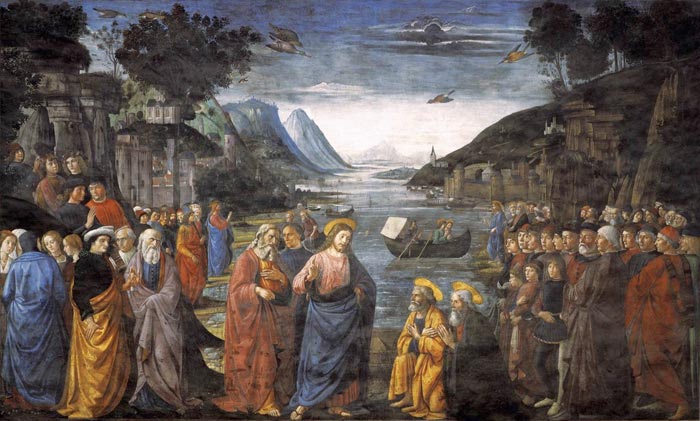 |
|
Domenico Ghirlandaio, Calling of the Apostles, 1481, fresco, 349 x 570 cm, Cappella Sistina, Vatican |
|
| In 1481–82 Domenico Ghirlandaio received an important commission in the Vatican for a fresco, representing the calling of Peter and Andrew to their Apostleship.[1] Although he is known to have created other works in Rome, they have been for centuries considered lost to history. He also produced frescoes, dated before 1485, for Cappella di Santa Fina, in the Tuscan Collegiata di San Gimignano which came under the rule of nearby Siena at the beginning of the 1350s. The style of Calling of the Apostles is reminiscent of the frescoes by Masaccio of about 1427, which had been the great innovating works of the early 15th century in Florence but by then must have seemed somewhat old-fashioned. The principal feature of this fresco is the group of portraits of the Florentine colony in Rome, who are represented as witnesses of the biblical event.[2] It has been suggested that the inclusion of these Florentines in a fresco painted for the Vatican had political significance, because the Florentine government had recently accused Pope Sixtus IV of complicity in the conspiracy of the Pazzi, another powerful Tuscan banking family, to murder the leading members of the Florentine Medici family. Ghirlandaio must have used his stay in Rome to study Roman antiquities at first hand, for many details of triumphal arches, ancient sarcophagi, and similar antique elements occur in his works throughout the rest of his career. |
| The fresco is from the cycle of the life of Christ in the Sistine Chapel, it is located in the third compartment on the north wall. Vasari wrote: "...Domenico represented Christ calling Peter and Andrew from their nets, and the Resurrection of Christ, the greater part of which is now destroyed, for it was above the door..." Later, the Resurrection vanished completely in the destruction of the wall. In the early 1480s Pope Sixtus IV brought a number of famous Tuscan and Umbrian artists to Rome in order to decorate his new court chapel, the Sistine Chapel. Ghirlandaio must already have made a name for himself with his commissions, primarily the frescoes for the Saint Fina Chapel, in order to be considered for a task of this importance. The chapel's ceiling would not be decorated with Michelangelo's famous frescoes until the reign of Sixtus' nephew, Julius II. Between 1481 and 1483, the walls of the chapel were covered with frescoes by Sandro Botticelli, Domenico Ghirlandaio, Cosimo Rosselli, Piero di Cosimo and others - probably under the direction of Pietro Perugino. On the left are scenes from the life of Moses, and on the right scenes from the life of Christ, a typological arrangement that sees Moses as the predecessor of Christ. This cycle of frescoes became one of the major artistic achievements of the Italian Quattrocento. In accordance with the Pope's wishes, in each picture several episodes of a story were presented together, a practice that by this time was already becoming outdated. The two frescoes Ghirlandaio painted were the Calling of Saint Peter and Resurrection. By Vasari's time the second fresco had been largely destroyed and an entirely new version was painted in the 16th century. The surviving work is divided into two zones. In the foreground, on a shallow stage, Ghirlandaio depicted several groups of people, tightly packed together in rows. At the centre Christ is blessing the kneeling brothers Simon, Peter and Andrew, His first disciples. They follow Him and appear again in the background on the right. There they witness Christ calling James and John, who are sitting in a boat mending their nets with their father, Zebedee. The massiveness of the heavy garments worn by the figures in the main scene in the centre foreground is reminiscent of Masaccio's frescoes in the Brancacci Chapel dating from about 1424 -1428. It is mainly Masaccio's Tribute Money that matches this one in terms of colour, landscape, figure types.
|
It is at the sides of the picture field that Ghirlandaio dares to display his own developing style. The group of women on the left, including a woman in blue seen from behind, anticipates the female figures he paints in later works. In this fresco he also gives a free rein to the highly individual style of portraiture he had developed in the Vespucci and Saint Fina chapels. |
 |
|
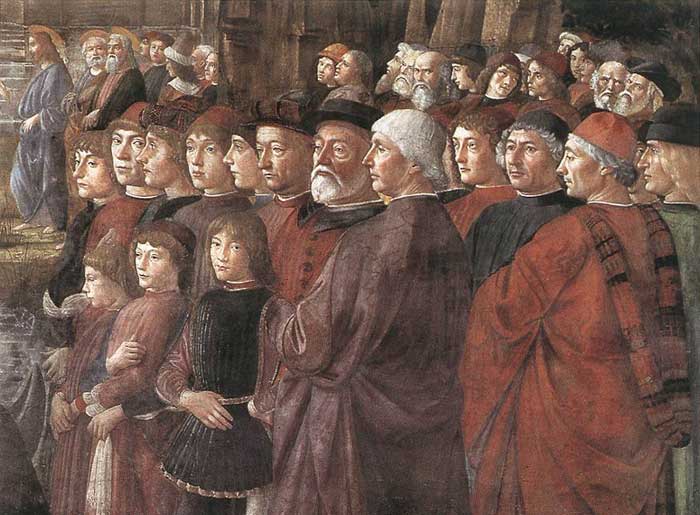 |
||
Domenico Ghirlandaio, Calling of the Apostles (detail), 1481, fresco in the Cappella Sistina, Rome |
||
On the right, arranged in an exactly level row like pearls on a string, are members of the most influential Florentine families who maintained residences in Rome. In the centre stands Giovanni Tornabuoni, representing the Medici family's merchant bank. He later became a sponsor of Ghirlandaio and was made the Pope's treasurer despite the enduring enmity between Pope Sixtus IV and the Medici. |
||
| It was not only his skill in portraits but also his skill in landscapes, visible in the fresco in the Sistine Chapel, that made Ghirlandaio famous. The entire upper half of this work is devoted to an extensive landscape with a high horizon. The Sea of Galilee, hemmed in by hills and mountains, is snaking its way like a river into the background, where, in accordance with aerial perspective, the colours are paler and lighter. In the sky brightly coloured birds are swooping - birds derived from Benozzo Gozzoli's Procession of the Magi, painted between 1459 and 1461 for the Florence Medici palace, and also from works by Domenico Veneziano. | ||
Art in Tuscany | Domenice Ghirlandaio, Last Supper frescoes
|
||||
|
This page uses material from the Wikipedia article Domenico Ghirlandaio and Sistine Chapel, published under the GNU Free Documentation License.
|
||||
Holiday accomodation in Tuscany | Podere Santa Pia | Artist and writer's residency
|
||||
Podere Santa Pia |
Podere Santa Pia, garden view, April |
View from Podere Santa Pia
on the coast and Corsica |
||
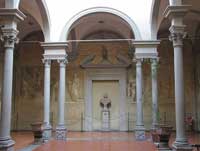 |
||||
Sansepolcro |
Bagni San Filippo |
Choistro dello Scalzo, Florence |
||
Monteriggioni |
Arcidosso |
Montefalco |
||

